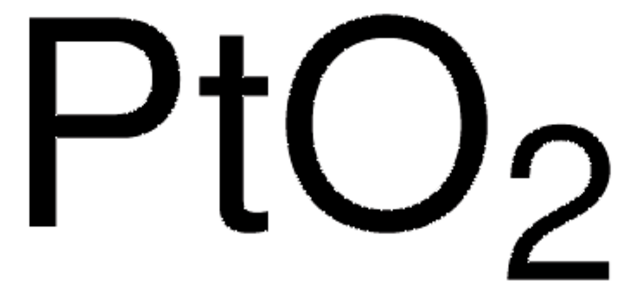685453
Platinum
nanopowder, <50 nm particle size (TEM)
Sinónimos:
Platinum black, Platinum element
About This Item
Productos recomendados
Formulario
nanopowder
Nivel de calidad
idoneidad de la reacción
reagent type: catalyst
core: platinum
resistividad
10.6 μΩ-cm, 20°C
tamaño de partícula
<50 nm (TEM)
bp
3827 °C (lit.)
mp
1772 °C (lit.)
densidad
21.45 g/cm3 (lit.)
cadena SMILES
[Pt]
InChI
1S/Pt
Clave InChI
BASFCYQUMIYNBI-UHFFFAOYSA-N
Descripción general
Aplicación
- Main Group SnN(4)O Single Sites with Optimized Charge Distribution for Boosting the Oxygen Reduction Reaction.: This research focuses on the application of SnN(4)O single sites, enhanced by platinum, to improve the oxygen reduction reaction, a crucial process in fuel cells and metal-air batteries. The study highlights the potential of these materials in creating more efficient and durable energy storage solutions. (Shao et al., 2024).
- Hydrogen spillover inspired bifunctional Platinum/Rhodium Oxide-Nitrogen-Doped carbon composite for enhanced hydrogen evolution and oxidation reactions in base.: This paper discusses a composite material using platinum and rhodium oxide, designed to enhance hydrogen evolution and oxidation reactions. This advancement is significant for renewable energy storage and hydrogen fuel cell technologies. (Kumar Manna et al., 2024).
- Rapid synthesis of high-purity molybdenum carbide with controlled crystal phases.: Although primarily focused on molybdenum carbide, this study provides insights into high-purity synthesis techniques that could be applicable to platinum-based materials, potentially benefiting academic research and industrial applications. (Fang et al., 2024).
- Solar-assisted selective separation and recovery of precious group metals from deactivated air purification catalysts.: This research explores a method for recovering platinum group metals from used catalysts using solar energy. This method could be beneficial for sustainable industrial practices and the recycling of high-value materials. (Wu et al., 2024).
Información legal
Palabra de señalización
Danger
Frases de peligro
Consejos de prudencia
Clasificaciones de peligro
Flam. Sol. 1
Código de clase de almacenamiento
4.1B - Flammable solid hazardous materials
Clase de riesgo para el agua (WGK)
nwg
Punto de inflamabilidad (°F)
Not applicable
Punto de inflamabilidad (°C)
Not applicable
Equipo de protección personal
Eyeshields, Gloves, type P3 (EN 143) respirator cartridges
Elija entre una de las versiones más recientes:
¿Ya tiene este producto?
Encuentre la documentación para los productos que ha comprado recientemente en la Biblioteca de documentos.
Los clientes también vieron
Artículos
Professor Ebrahimi and Professor Robinson (Pennsylvania State University, USA) summarize recent advances in the synthesis of these 2D materials, resulting material properties, and related applications in biosensing of neurotransmitters, metabolites, proteins, nucleic acids, bacterial cells, and heavy metals.
Dye-Sensitized and Perovskite Solar Cells: Interface Engineering by Atomic Layer Deposition
Graphene is a unique two-dimensional (2D) structure of monolayer carbon atoms packed into a dense honeycomb crystal that has attracted great interest due to its diverse and fascinating properties.
Electronically, it behaves as a wide band gap (3.2 eV) semiconductor and exhibits memristor properties.2 Optically, TiO2 has high opacity with a very high refractive index3 (>2.4), and it exhibits strong absorbance in the UV range.
Nuestro equipo de científicos tiene experiencia en todas las áreas de investigación: Ciencias de la vida, Ciencia de los materiales, Síntesis química, Cromatografía, Analítica y muchas otras.
Póngase en contacto con el Servicio técnico






![Poly[2-methoxy-5-(2-ethylhexyloxy)-1,4-phenylenevinylene] average Mn 40,000-70,000](/deepweb/assets/sigmaaldrich/product/structures/344/488/b8f8179d-3970-4deb-a754-adda88cdb36f/640/b8f8179d-3970-4deb-a754-adda88cdb36f.png)
